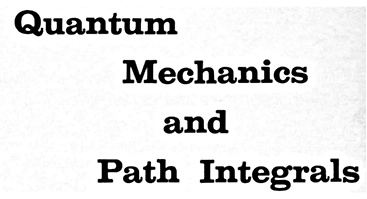
\(\)
Problem 6-10
Consider a diatomic molecule containing two atoms, \(A\) and \(B\), arranged with their centers at the points given by the vectors \(\mathbf{a}\) and \(\mathbf{b}\). Using the Born approximation, show that the amplitude for an electron to be scattered from such a molecule is
\begin{equation}
\def\mb#1{\mathbf{#1}}
K^{(1)} = e^{i\mb{q}\cdot\mb{a}/\hbar} f_A(\mb{q})+e^{i\mb{q}\cdot\mb{b}/\hbar} f_B(\mb{q})
\tag{6-57}
\end{equation}
\def\mb#1{\mathbf{#1}}
K^{(1)} = e^{i\mb{q}\cdot\mb{a}/\hbar} f_A(\mb{q})+e^{i\mb{q}\cdot\mb{b}/\hbar} f_B(\mb{q})
\tag{6-57}
\end{equation}
where \(f_A\) and \(f_B\) are the amplitudes for scattering by the two atoms individually when each atom is located at the center of a coordinate system. The atomic binding does not change the charge distributions around the nuclei very much (except for very light nuclei such as hydrogen) because the binding forces affect only a few of the outermost electrons.
Using Eq. (6-57), show that the probability of scattering at a particular value of \(q\) is proposional to \(f_A^{2} +f_B^{2}+2f_A f_B \cos\mb{q}\cdot\mb{d}/\hbar\), where \(\mathbf{d}\) is \(\mathbf{a}-\mathbf{b}\).
( 解答例 ) 原子 \(A\) からの散乱振幅 \(K^{(1)}_A=f_A(\mathbf{q})\), 及び原子 \(B\) からの散乱振幅 \(K^{(1)}_B=f_B(\mathbf{q})\) を考える.それら個別の散乱振幅は, 式 (6-38) から次のように書けるはずである:
\begin{align}
K^{(1)}&=-\frac{i}{\hbar}\left(\frac{m}{2\pi i\hbar}\right)^{5/2}\frac{u}{T^{1/2}R_cR_d}\exp\left(\frac{im}{2\hbar}u^{2}T\right)
\int d^{3}\mb{r}\,e^{i\mb{q}\cdot\mb{r}/\hbar}\,V(\mb{r})\notag\\
&=-\frac{i}{\hbar}\left(\frac{m}{2\pi i\hbar}\right)^{5/2}\frac{u}{T^{1/2}R_cR_d}\exp\left(\frac{im}{2\hbar}u^{2}T\right)\,v(\mb{q})
\tag{1}
\end{align}
K^{(1)}&=-\frac{i}{\hbar}\left(\frac{m}{2\pi i\hbar}\right)^{5/2}\frac{u}{T^{1/2}R_cR_d}\exp\left(\frac{im}{2\hbar}u^{2}T\right)
\int d^{3}\mb{r}\,e^{i\mb{q}\cdot\mb{r}/\hbar}\,V(\mb{r})\notag\\
&=-\frac{i}{\hbar}\left(\frac{m}{2\pi i\hbar}\right)^{5/2}\frac{u}{T^{1/2}R_cR_d}\exp\left(\frac{im}{2\hbar}u^{2}T\right)\,v(\mb{q})
\tag{1}
\end{align}
ただし, \(v(\mb{q})\) は式 (6-39) で定義されていた:
\begin{equation}
v(\mb{q})=\int d^{3}\mb{r}\,e^{i\mb{q}\cdot\mb{r}/\hbar}\,V(\mb{r})
\tag{2}
\end{equation}
v(\mb{q})=\int d^{3}\mb{r}\,e^{i\mb{q}\cdot\mb{r}/\hbar}\,V(\mb{r})
\tag{2}
\end{equation}
2 原子間距離 \(|\mb{a}-\mb{b}|\) は \(R_c,R_d\) と比べて無視出来る位に微小であるから, 同じ \(T\) で \(R_c\) と \(r_c\), \(R_d\) と \(r_d\) とは, ほぼ等しいと見做してよい.よって両者は, 次のように書くことが出来よう:
\begin{equation}
K^{(1)}_A=C\int d^{3}\mb{r}_a\,e^{i\mb{q}\cdot\mb{r}_a/\hbar}\,V_A(\mb{r}_a),\quad
K^{(1)}_B=C\int d^{3}\mb{r}_b\,e^{i\mb{q}\cdot\mb{r}_b/\hbar}\,V_B(\mb{r}_b)
\tag{3}
\end{equation}
K^{(1)}_A=C\int d^{3}\mb{r}_a\,e^{i\mb{q}\cdot\mb{r}_a/\hbar}\,V_A(\mb{r}_a),\quad
K^{(1)}_B=C\int d^{3}\mb{r}_b\,e^{i\mb{q}\cdot\mb{r}_b/\hbar}\,V_B(\mb{r}_b)
\tag{3}
\end{equation}
すなわち, 散乱振幅は積分部分が本質的である.また「1次のボルン振幅」 \(f^{(1)}\) は式 (6-39) の \(v(\mb{q})\) を用いて次のように書けるのであった:
\begin{equation}
f^{(1)}(\mb{q})\simeq -\frac{m}{2\pi\hbar^{2}}\int d^{3}\mb{x}\,e^{i\mb{q}\cdot\mb{x}/\hbar}\,V(\mb{x})
=-\frac{m}{2\pi\hbar^{2}}\,v(\mb{q})
\tag{4}
\end{equation}
f^{(1)}(\mb{q})\simeq -\frac{m}{2\pi\hbar^{2}}\int d^{3}\mb{x}\,e^{i\mb{q}\cdot\mb{x}/\hbar}\,V(\mb{x})
=-\frac{m}{2\pi\hbar^{2}}\,v(\mb{q})
\tag{4}
\end{equation}
以上のことから, 各原子の散乱振幅を次のように書くことにしよう:
\begin{align}
f_A(\mb{q})&=C v(\mb{q})_A=C\int d^{3}\mb{r}_a\,e^{i\mb{q}\cdot\mb{r}_a/\hbar}\,V_A(\mb{r}_a),\\
f_B(\mb{q})&=C v(\mb{q})_B=C \int d^{3}\mb{r}_b\,e^{i\mb{q}\cdot\mb{r}_b/\hbar}\,V_B(\mb{r}_b)
\tag{5}
\end{align}
f_A(\mb{q})&=C v(\mb{q})_A=C\int d^{3}\mb{r}_a\,e^{i\mb{q}\cdot\mb{r}_a/\hbar}\,V_A(\mb{r}_a),\\
f_B(\mb{q})&=C v(\mb{q})_B=C \int d^{3}\mb{r}_b\,e^{i\mb{q}\cdot\mb{r}_b/\hbar}\,V_B(\mb{r}_b)
\tag{5}
\end{align}
2原子分子のポテンシャルは \(V(\mb{r})=V_A(\mb{r}-\mb{a})+V_B(\mb{r}-\mb{b})\) と書ける.\(\mb{r}_a=\mb{r}-\mb{a}\), \(\mb{r}_b=\mb{r}-\mb{b}\) とするならば \(d^{3}\mb{r}_a=d^{3}\mb{r}\) 及び \(d^{3}\mb{r}_b=d^{3}\mb{r}\) なので, 分子全体の散乱振幅は次に書ける:
\begin{align}
K^{(1)}&=C v(\mb{q})=C\int d^{3}\mb{r}\,e^{i\mb{q}\cdot\mb{r}/\hbar}\,V(\mb{r})\\
&=C\int d^{3}\mb{r}\,e^{i\mb{q}\cdot\mb{r}/\hbar}\,\Bigl[V_A(\mb{r}-\mb{a})+V_B(\mb{r}-\mb{b})\Bigr]\\
&=C\int d^{3}\mb{r}\,e^{i\mb{q}\cdot\mb{r}/\hbar}\,V_A(\mb{r}-\mb{a})
+C\int d^{3}\mb{r}\,e^{i\mb{q}\cdot\mb{r}/\hbar}\,V_B(\mb{r}-\mb{b})\\
&=C\int d^{3}\mb{r}_a\,e^{i\mb{q}\cdot(\mb{r}_a+\mb{a})/\hbar}\,V_A(\mb{r}_a)
+C\int d^{3}\mb{r}_b\,e^{i\mb{q}\cdot(\mb{r}_b+\mb{b})/\hbar}\,V_B(\mb{r}_b)\\
&=e^{i\mb{q}\cdot\mb{a}/\hbar}\,C\int d^{3}\mb{r}_a\,e^{i\mb{q}\cdot\mb{r}_a/\hbar}\,V_A(\mb{r}_a)
+e^{i\mb{q}\cdot\mb{b}/\hbar}\,C\int d^{3}\mb{r}_b\,e^{i\mb{q}\cdot\mb{r}_b/\hbar}\,V_B(\mb{r}_b)\\
&=e^{i\mb{q}\cdot\mb{a}/\hbar}\,f_A(\mb{q})+e^{i\mb{q}\cdot\mb{b}/\hbar}\,f_B(\mb{q})
\tag{6}
\end{align}
K^{(1)}&=C v(\mb{q})=C\int d^{3}\mb{r}\,e^{i\mb{q}\cdot\mb{r}/\hbar}\,V(\mb{r})\\
&=C\int d^{3}\mb{r}\,e^{i\mb{q}\cdot\mb{r}/\hbar}\,\Bigl[V_A(\mb{r}-\mb{a})+V_B(\mb{r}-\mb{b})\Bigr]\\
&=C\int d^{3}\mb{r}\,e^{i\mb{q}\cdot\mb{r}/\hbar}\,V_A(\mb{r}-\mb{a})
+C\int d^{3}\mb{r}\,e^{i\mb{q}\cdot\mb{r}/\hbar}\,V_B(\mb{r}-\mb{b})\\
&=C\int d^{3}\mb{r}_a\,e^{i\mb{q}\cdot(\mb{r}_a+\mb{a})/\hbar}\,V_A(\mb{r}_a)
+C\int d^{3}\mb{r}_b\,e^{i\mb{q}\cdot(\mb{r}_b+\mb{b})/\hbar}\,V_B(\mb{r}_b)\\
&=e^{i\mb{q}\cdot\mb{a}/\hbar}\,C\int d^{3}\mb{r}_a\,e^{i\mb{q}\cdot\mb{r}_a/\hbar}\,V_A(\mb{r}_a)
+e^{i\mb{q}\cdot\mb{b}/\hbar}\,C\int d^{3}\mb{r}_b\,e^{i\mb{q}\cdot\mb{r}_b/\hbar}\,V_B(\mb{r}_b)\\
&=e^{i\mb{q}\cdot\mb{a}/\hbar}\,f_A(\mb{q})+e^{i\mb{q}\cdot\mb{b}/\hbar}\,f_B(\mb{q})
\tag{6}
\end{align}
式 (6-40) のところで述べられているように, コリメーターが設置されて中心粒子線から十分遠くの領域では, 電子の到達する確率は \(K^{(1)}\) の絶対値の 2 乗だけで与えられるのであった.また, 単位立体角当たりの散乱断面積 (微分散乱断面積) は, 式 (6-44) のようにかけるのであった:
\begin{equation}
\frac{d\sigma}{d\Omega}=\left(\frac{m}{2\pi\hbar}\right)^{2}\big|v(\mb{p})\big|^{2}=\Big| f^{(1)}(\mb{q})\Big|^{2}
\tag{7}
\end{equation}
\frac{d\sigma}{d\Omega}=\left(\frac{m}{2\pi\hbar}\right)^{2}\big|v(\mb{p})\big|^{2}=\Big| f^{(1)}(\mb{q})\Big|^{2}
\tag{7}
\end{equation}
よって \(f_A(\mb{q})\) と \(f_B(\mb{q})\) は実数であることに注意して式 (6) の絶対値をとることで, 目的の結果が得られる:
\begin{align}
|K^{(1)}|^{2}&=C^{2}|v(\mb{q})|^{2}\\
&=\left( e^{i\mb{q}\cdot\mb{a}/\hbar}\,f_A(\mb{q})+e^{i\mb{q}\cdot\mb{b}/\hbar}\,f_B(\mb{q})\right)^{*}\cdot
\left( e^{i\mb{q}\cdot\mb{a}/\hbar}\,f_A(\mb{q})+e^{i\mb{q}\cdot\mb{b}/\hbar}\,f_B(\mb{q})\right)\\
&=\left( e^{-i\mb{q}\cdot\mb{a}/\hbar}\,f_A(\mb{q})+e^{-i\mb{q}\cdot\mb{b}/\hbar}\,f_B(\mb{q})\right) \cdot
\left( e^{i\mb{q}\cdot\mb{a}/\hbar}\,f_A(\mb{q})+e^{i\mb{q}\cdot\mb{b}/\hbar}\,f_B(\mb{q})\right)\\
&=f_A(\mb{q})^{2}+f_B(\mb{q})^{2}+e^{-i\mb{q}\cdot(\mb{a}-\mb{b})/\hbar}f_A(\mb{q})f_B(\mb{q})
+e^{i\mb{q}\cdot(\mb{a}-\mb{b})/\hbar}f_A(\mb{q})f_B(\mb{q})\\
&=f_A(\mb{q})^{2}+f_B(\mb{q})^{2}+f_A(\mb{q})f_B(\mb{q})\left\{e^{i\mb{q}\cdot(\mb{a}-\mb{b})/\hbar}
+e^{-i\mb{q}\cdot(\mb{a}-\mb{b})/\hbar}\right\}\\
&=f_A^{2}(\mb{q})+f_B^{2}(\mb{q})+f_A(\mb{q})f_B(\mb{q})\times 2\cos \mb{q}\cdot(\mb{a}-\mb{b})/\hbar\\
&=f_A^{2}+f_B^{2}+2f_Af_B\cos(\mb{q}\cdot\mb{d}/\hbar)
\tag{8}
\end{align}
|K^{(1)}|^{2}&=C^{2}|v(\mb{q})|^{2}\\
&=\left( e^{i\mb{q}\cdot\mb{a}/\hbar}\,f_A(\mb{q})+e^{i\mb{q}\cdot\mb{b}/\hbar}\,f_B(\mb{q})\right)^{*}\cdot
\left( e^{i\mb{q}\cdot\mb{a}/\hbar}\,f_A(\mb{q})+e^{i\mb{q}\cdot\mb{b}/\hbar}\,f_B(\mb{q})\right)\\
&=\left( e^{-i\mb{q}\cdot\mb{a}/\hbar}\,f_A(\mb{q})+e^{-i\mb{q}\cdot\mb{b}/\hbar}\,f_B(\mb{q})\right) \cdot
\left( e^{i\mb{q}\cdot\mb{a}/\hbar}\,f_A(\mb{q})+e^{i\mb{q}\cdot\mb{b}/\hbar}\,f_B(\mb{q})\right)\\
&=f_A(\mb{q})^{2}+f_B(\mb{q})^{2}+e^{-i\mb{q}\cdot(\mb{a}-\mb{b})/\hbar}f_A(\mb{q})f_B(\mb{q})
+e^{i\mb{q}\cdot(\mb{a}-\mb{b})/\hbar}f_A(\mb{q})f_B(\mb{q})\\
&=f_A(\mb{q})^{2}+f_B(\mb{q})^{2}+f_A(\mb{q})f_B(\mb{q})\left\{e^{i\mb{q}\cdot(\mb{a}-\mb{b})/\hbar}
+e^{-i\mb{q}\cdot(\mb{a}-\mb{b})/\hbar}\right\}\\
&=f_A^{2}(\mb{q})+f_B^{2}(\mb{q})+f_A(\mb{q})f_B(\mb{q})\times 2\cos \mb{q}\cdot(\mb{a}-\mb{b})/\hbar\\
&=f_A^{2}+f_B^{2}+2f_Af_B\cos(\mb{q}\cdot\mb{d}/\hbar)
\tag{8}
\end{align}
